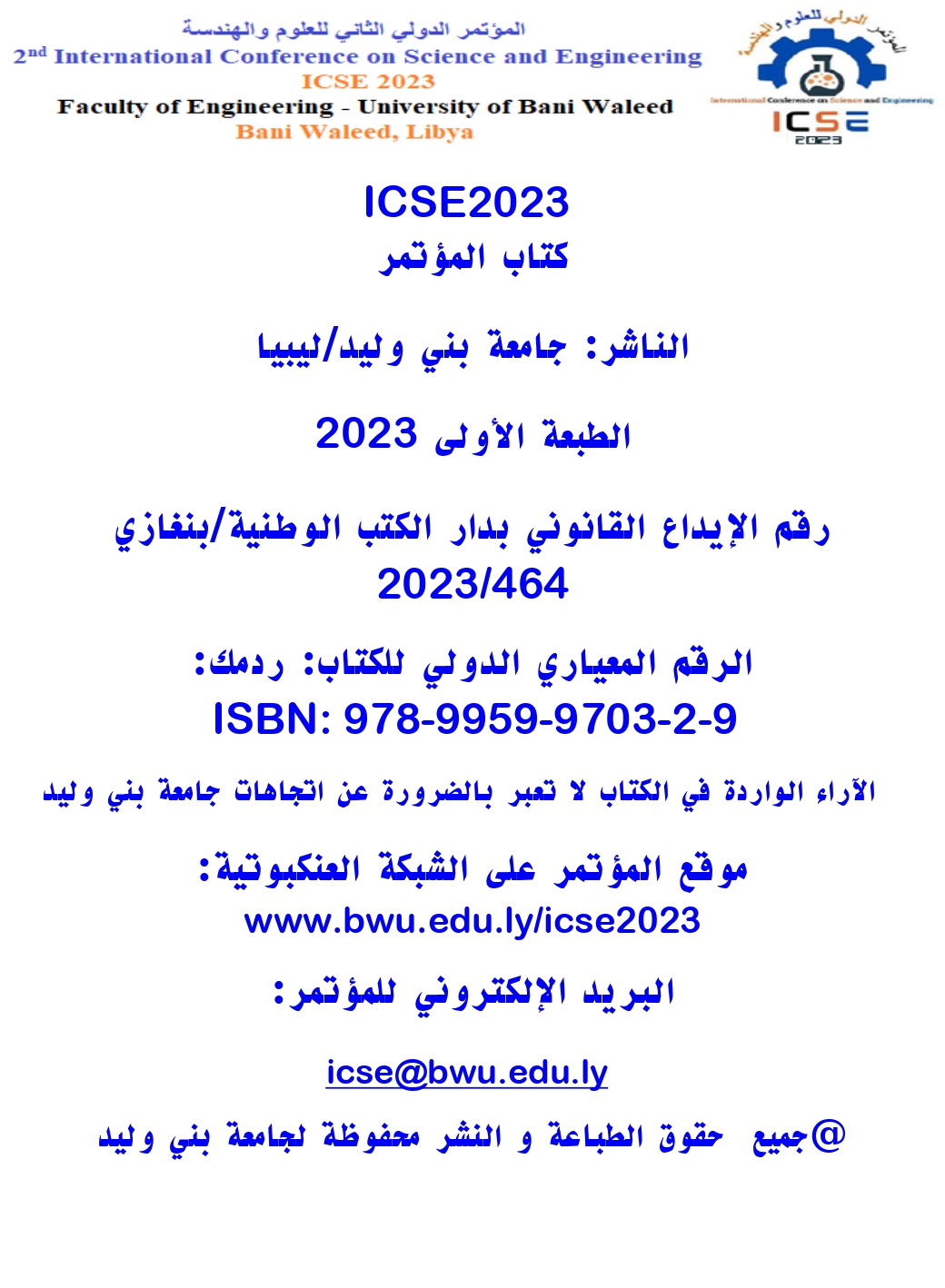Influence of Waste Polystyrene Foam on the Engineering Properties of Concrete Made from Local Materials
DOI:
https://doi.org/10.58916/jhas.v8i3.117الكلمات المفتاحية:
Plain concrete، Engineering properties، Waste polystyrene foam، Natural sandالملخص
One of the waste materials currently used in the manufacture of lightweight concrete is polystyrene. However, the effects of this material on most concrete properties have not been studied in Libya. In this paper, experimental data for plain concrete were obtained by replacing natural sand with waste polystyrene foam (WPSF) in volume ratios of 0%, 10%, 20%, and 30%. The properties of concrete, such as slump, air content, density, water absorption, compressive strength, flexural strength, free shrinkage, and UPV, were determined experimentally. The findings indicate that as the amount of WPSF in the concrete mix increases, the slump, density, compressive strength, and flexural strength as well as the elastic modulus and UPV of the plain concrete decrease. Conversely, an increase in the replacement level of natural sand by WPSF leads to an increase in air content, water absorption, and free shrinkage. Even though the incorporation of WPSF did not enhance most of the established engineering properties of concrete, the results obtained still fall within the acceptable limits for concrete use in all engineering applications. As such, this type of concrete may be suitable for construction applications that require less thermal and acoustic insulation.
التنزيلات
المراجع
Altwair, N., M. & Sryh, L., S., (2020), Effect of Sawdust on The Mechanical Properties of Mortar Using Local Materials, Third Conference for Engineering Sciences and Technology, 1-3 December 2020 /Alkhoms –Libya. DOI: http://dspace.elmergib.edu.ly/xmlui/handle/123456789/208.
Akcaozoglu, S. & Atis, C.D., (2011), Effect of Granulated Blast Furnace Slag and Fly Ash Addition on the Strength Properties of Lightweight Mortars Containing Waste PET Aggregates. Constr Build Mater, 25, 4052–8. DOL: https://doi.org/10.1016/j.conbuildmat.2011.04.042
Kockal, N.U & Ozturan, T., (2011), Strength and Elastic Properties of Structural Lightweight Concretes. Mater Des ,32, 2396–403. DOL: https://doi.org/10.1016/j.matdes.2010.12.053
Altwair, N.M., Megat Johari, M.A., and Saiyid Hashim, S.F., (2012), Flexural Performance of Green Engineered Cementitious Composites Containing High Volume of Palm Oil Fuel Ash, Const. Build. Mater., 37, 518–525. DOI: https://doi.org/10.1016/j.conbuildmat.2012.08.003.
Altwair, N.M., Johari, M.A.M., and Hashim, S.F.S., (2013), Influence of Treated Palm Oil Fuel Ash on Compressive Properties and Chloride Resistance of Engineered Cementitious Composites. Mater. Structu., 47, 667–682. doi:10.1617/s11527-013-0087-4.
Pczieczek, A., Schackow, A., Effting, C., Dias, T. F. & Gomes, I., (2018), Properties of Mortars Containing Tire Rubber Waste and Expanded Polystyrene (EPS), Urb. Enviro. Eng., 11, 219-225. DOI: 10.4090/juee.2017.v11n2.219225
Ferrándiz-Mas, V. & García-Alcocel, E., (2013), Durability of Expanded Polystyrene Mortars, Constr. Build. Mater., 46, 175-182. DOI: https://doi.org/10.1016/j.conbuildmat.2013.04.029
Ubi, S. E., Ewa, D. E., Bessong, A. R. & Nyah, K. D, (2022), Effects of Incorporating Expanded Polystyrene in Concrete Construction., Buil. Constr. Plan. Res., 10, 79-101. DOL: 10.4236/jbcpr.2022.103004.
Herki, B. A. & Khatib, J. M., (2013), Lightweight Concrete Incorporating Waste Expanded Polystyrene, Adv. Mate. Res., 787, 131-137. DOI: https://doi.org/10.4028/www.scientific.net/AMR.787.131.
Babu, K.G., Babu, D.S. & Wee, T.H., (2006), Effect of Polystyrene Aggregate Size on Strength and Moisture Migration Characteristics of Lightweight Concrete. Cem. Conc. Comp., 28, 520-527.DOI: https://doi.org/10.1016/j.cemconcomp.2006.02 .018
Ferrándiz-Mas V & García-Alcocel E., (2012), Physical and Mechanical Characterization of Portland Cement Mortars Made with Expanded Polystyrene Particles Addition, Mater. Constr, 62, 547–66. DOI: 10.3989/mc.2012.04611.
LSS 340-09, Libyan Standard Specifications in Portland Cement, Libyan National Center for Standardization and Metrology, 2009.
BSI 812-95, Methods of Sampling and Testing of Mineral Aggregates, Sands, Fillers, Part 1, British Standard Institution (BSI), London, 1995.
Mazizah, E. M., Robert T., Razak, A., Kifli, A. Z. & Nisa A., (2022), Compressive Strength of Concrete Containing Expanded Polystyrene Styrofoam (EPS) Concrete and Partial Cement Replacement of Fly Ash and Silica Fume, Mechan. Eng., 11, 301-317. DOI: https://doi.org/10.1177/2633366X2091.
ASTM C185 – 15, Standard Test Method for Air Content of Hydraulic Cement Mortar, ASTM International: West Conshohocken, PA, USA, 2015.
ASTM C143/C143M-00. Standard Test Method for Slump of Hydraulic-Cement Concrete, ASTM International: West Conshohocken, PA, USA, 2000.
BS 1881-114, testing concrete - Methods for Determination of Density of Hardened Concrete, British Standard, Part 114, British Standard Institution (BSI), London, 1983.
ASTM C642, Standard Test Method for Density, Absorption, and Voids in Hardened Concrete, ASTM International: West Conshohocken, PA, USA, 2013.
Bengin M. A. H., (2017), Absorption Characteristics of Lightweight Concrete Containing Densified Polystyrene, Civi. Eng. J., 3, 594-609. DOI: 10.28991/cej-2017-00000115
BS 1881-116, Testing concrete. Method for Determination of Compressive Strength of Concrete Cubes, Fillers, Part 1, British Standard Institution (BSI), London, 1983.
ASTM C78/C78M – 16, Standard Test Method for Flexural Strength of Concrete (Using Simple Beam with Third- Point Loading) ASTM International: West Conshohocken, PA, USA, 2016.
ACI 318-08, (2008), Building Code Requirements for Structural Concrete and Commentary. American Concrete Institute.
ASTM C157/C157M-08 Standard Test Method for Length Change of Hardened Hydraulic-Cement Mortar and Concrete, ASTM International, West Conshohocken, PA, USA, 2008.
ASTM C597–09, Standard Test Method for Pulse Velocity Through Concrete, ASTM International, West Conshohocken, PA, USA, 2009.
Kin, L. W. & Ariffin, M. A. M., (2016), Strength Properties of Expanded Polystyrene Concrete and Cold Formed Steel Wall Frame Composite, Mater. Scie., 11, 126-173. DOI: 10.36108/laujoces/9102/20(0121
Roman C. , Tomáš T. , Fládr, J. & Petr B., (2017), Mechanical properties and durability of crumb rubber concrete, Mater. Sci. Eng.g, 236, 1-7. DOI: 10.1088/1757-899X/236/1/012093
Herki, B. A. & Khatib, j., (2016), Valorisation of Waste Expanded Polystyrene in Concrete Using a Novel Recycling Technique, Europe. J. Environ. Civi. Eng., 1-19. DOI:
doi.org/10.1080/19648189.2016.1170729
Askar, L. K., Albarwary, I. H. & Askar, M. K., (2019), Use of Expanded Polystyrene (Eps) Beads in Silica-Fume Concrete, J. Univ. Duhok, 22, 30-38. DOI:
https://doi.org/10.26682/sjuod.2019.22.1.5
Salahaldeen, A. S., & Al-Hadithi, A. I., (2022), The Effect of Adding Expanded Polystyrene Beads (EPS) on the Hardened Properties of Concrete, Eng. Tech. Appl. Sci. Rese., 12, 9692-9696. DOI:
https://doi.org/10.48084/etasr.5278
Tang, W.C., Lo, Y. & Nadeem, A., (2008), Mechanical and Drying Shrinkage Properties of Structural-graded Polystyrene Aggregate Concrete, Cem. Conc. Comp., 30, 403–409. DOI: https://doi.org/10.1016/j.cemconcomp.2008.01.002
Elsalah, J., Al-Sahli, Y., Akish, A., Saad, O., & Hakemi, A., (2013). The Influence of Recycled Expanded Polystyrene (EPS) on Concrete Properties: Influence on Flexural Strength, Water Absorption and Shrinkage, AIP Conference Proceedings, 1569, 181–185.














